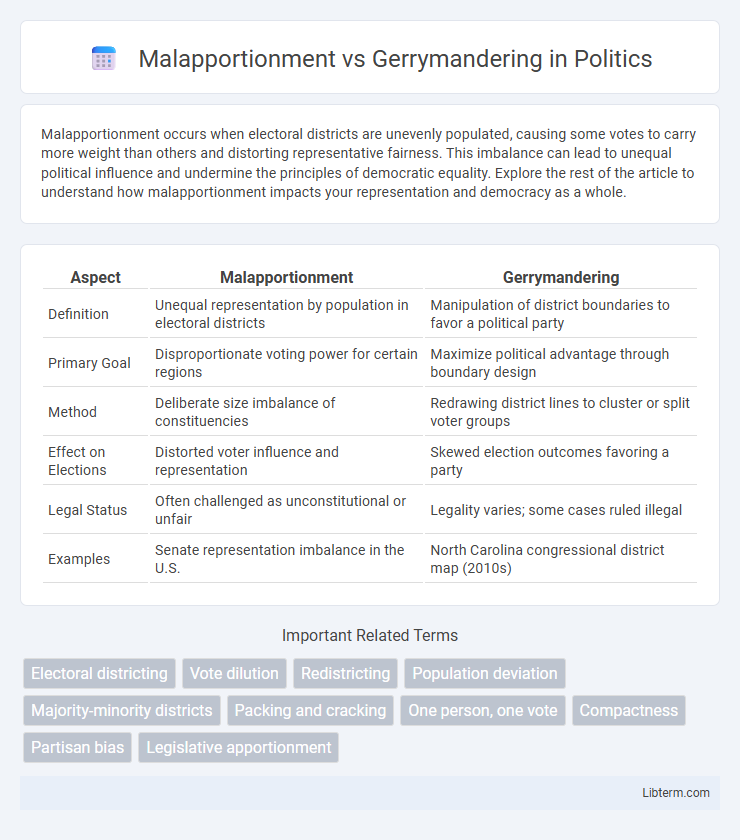Malapportionment occurs when electoral districts are unevenly populated, causing some votes to carry more weight than others and distorting representative fairness. This imbalance can lead to unequal political influence and undermine the principles of democratic equality. Explore the rest of the article to understand how malapportionment impacts your representation and democracy as a whole.
Table of Comparison
| Aspect | Malapportionment | Gerrymandering |
|---|---|---|
| Definition | Unequal representation by population in electoral districts | Manipulation of district boundaries to favor a political party |
| Primary Goal | Disproportionate voting power for certain regions | Maximize political advantage through boundary design |
| Method | Deliberate size imbalance of constituencies | Redrawing district lines to cluster or split voter groups |
| Effect on Elections | Distorted voter influence and representation | Skewed election outcomes favoring a party |
| Legal Status | Often challenged as unconstitutional or unfair | Legality varies; some cases ruled illegal |
| Examples | Senate representation imbalance in the U.S. | North Carolina congressional district map (2010s) |
Understanding Malapportionment and Gerrymandering
Malapportionment occurs when electoral districts have significantly unequal populations, resulting in unequal representation and voting power among constituents. Gerrymandering involves deliberately redrawing district boundaries to favor a specific political party or group, manipulating electoral outcomes without necessarily changing population sizes. Both practices undermine democratic fairness by distorting the principle of "one person, one vote.
Historical Origins of Electoral Distortions
Malapportionment and gerrymandering both originated as tactics to manipulate electoral outcomes by distorting district boundaries and population representation. Malapportionment traces back to early 20th-century U.S. politics, where uneven district populations diluted the voting power of urban areas. Gerrymandering dates back to 1812 in Massachusetts, named after Governor Elbridge Gerry's redistricting plan that created oddly shaped districts to favor his party's candidates.
Key Differences Between Malapportionment and Gerrymandering
Malapportionment occurs when electoral districts have significantly unequal populations, leading to disproportionate representation in legislative bodies, whereas gerrymandering involves manipulating district boundaries to favor a particular political party or group. Malapportionment directly impacts the principle of "one person, one vote" by creating imbalanced voter influence, while gerrymandering strategically designs districts to dilute or concentrate voting power for partisan advantage. Both practices undermine electoral fairness, but malapportionment centers on population inequality, and gerrymandering focuses on boundary manipulation for political gain.
Legal Frameworks and Court Rulings
Malapportionment and gerrymandering are addressed through distinct legal frameworks centered on equal representation and fair districting practices, with landmark court rulings such as Reynolds v. Sims establishing the principle of "one person, one vote" to combat malapportionment. The U.S. Supreme Court, in cases like Baker v. Carr, recognized judicial authority to review redistricting claims, leading to standards that limit racial gerrymandering under the Voting Rights Act and prevent vote dilution. State and federal courts continue to interpret constitutional provisions under the Equal Protection Clause and Voting Rights Act enforcement, shaping electoral district boundaries to balance political fairness and demographic realities.
Impact on Political Representation
Malapportionment distorts political representation by creating voting districts with unequal populations, which causes some votes to carry more weight than others and undermines democratic fairness. Gerrymandering manipulates district boundaries to favor specific political parties or groups, resulting in skewed electoral outcomes that do not accurately reflect voter preferences. Both practices erode public trust in electoral systems by diminishing the principle of equal representation and affecting legislative balance.
Case Studies: Global Examples
Malapportionment in Japan's House of Representatives led to unequal voter representation, prompting judicial intervention to rebalance districts. In the United States, gerrymandering in states like North Carolina manipulated district boundaries to favor political parties, resulting in numerous legal challenges. Australia's reform efforts in the 1980s addressed both malapportionment and gerrymandering by establishing independent electoral commissions to ensure fairer representation.
Consequences for Voter Equality
Malapportionment skews voter equality by creating electoral districts with significantly unequal populations, leading to unequal representation where votes in smaller districts carry more weight than those in larger ones. Gerrymandering manipulates district boundaries to favor particular parties or groups, distorting electoral outcomes and undermining the principle of fair representation. Both practices erode democratic legitimacy by compromising the principle of "one person, one vote," resulting in diminished voter influence and skewed policy responsiveness.
Reform Efforts and Proposed Solutions
Reform efforts addressing malapportionment and gerrymandering include independent redistricting commissions, which aim to create more equitable voting districts by reducing partisan bias and ensuring population equality. Legal frameworks such as the Voting Rights Act and court rulings have challenged unfair district boundaries, promoting transparency and fairness in the redistricting process. Technological innovations like algorithmic mapping tools provide data-driven solutions for drawing districts based on objective criteria, enhancing accountability and minimizing political manipulation.
Public Perceptions and Political Controversy
Malapportionment, which involves unequal representation due to population disparities across districts, often leads to public distrust in electoral fairness and fuels debates over democratic legitimacy. Gerrymandering, the deliberate manipulation of district boundaries to favor specific political parties or groups, intensifies political controversy by undermining competitive elections and skewing policy outcomes. Both practices diminish voter confidence and prompt widespread calls for reform to ensure equitable representation and maintain the integrity of democratic processes.
The Future of Fair Redistricting
Emerging technologies and independent redistricting commissions are poised to enhance the future of fair redistricting by mitigating malapportionment and gerrymandering. Geographic Information Systems (GIS) enable precise mapping that respects community boundaries and population equality, fostering more equitable representation. Legal reforms and public transparency initiatives further support accountability, ensuring district maps reflect voter demographics without partisan bias.
Malapportionment Infographic

 libterm.com
libterm.com